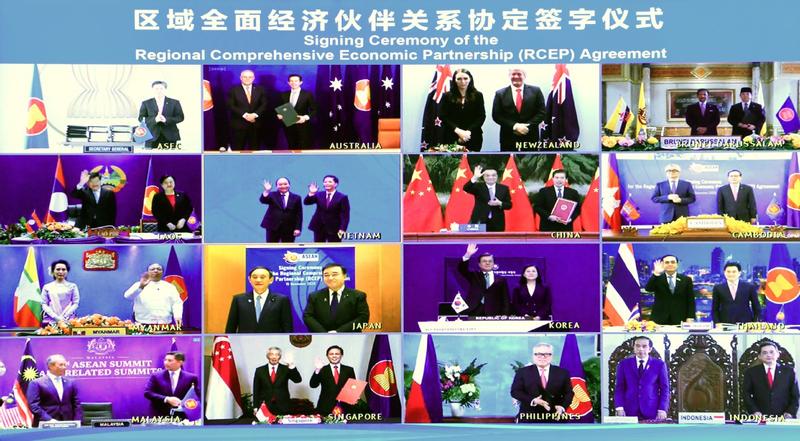 Leaders and trade ministers from ASEAN and the 15 Regional Comprehensive Economic Partnership countries pose for a virtual group photo at a videoconference hosted by Vietnam on Nov 15, 2020. The countries will form the world's largest trading bloc, encompassing nearly a third of all economic activity. (ZHANG LING / XINHUA)
Leaders and trade ministers from ASEAN and the 15 Regional Comprehensive Economic Partnership countries pose for a virtual group photo at a videoconference hosted by Vietnam on Nov 15, 2020. The countries will form the world's largest trading bloc, encompassing nearly a third of all economic activity. (ZHANG LING / XINHUA)
The Regional Comprehensive Economic Partnership agreement, signed by 15 Asia-Pacific countries on Sunday, will accelerate the integration of the regional market and facilitate Chinese companies' investment and business operations overseas, industry experts said.
Applying unified trade and investment rules including that on tariff elimination, dispute settlement mechanism, and investment protection, the most significant influence of the RCEP is that it ties up the member countries much closer to form a huge and deeply integrated regional market.
Zhang Jianping, director-general of the China Center for Regional Economic Cooperation
Involving China, Japan, South Korea, Australia, New Zealand and the 10 member states of the Association of Southeast Asian Nations, the RCEP aims to cut tariffs, open markets and lower barriers to liberalize trade and investment in the member countries that account for about a third of the world's population and economic and trade volume, according to the Ministry of Commerce.
"Applying unified trade and investment rules including that on tariff elimination, dispute settlement mechanism, and investment protection, the most significant influence of the RCEP is that it ties up the member countries much closer to form a huge and deeply integrated regional market," said Zhang Jianping, director-general of the China Center for Regional Economic Cooperation.
ALSO READ: RCEP pact 'victory of multilateralism, free trade'
Companies of member countries, including those from China, will be able to utilize resources in a much better way than within a free-trade agreement. They will be able to organize intra-regional production, trade and other investment activities, which means more room to increase efficiency and reduce costs, he said.
The unified trade and investment rules, especially the regional rule of origin, which officially defines if a product comes from any of the member countries that can benefit from tariff eliminations, will significantly reduce intra-regional trade costs and product prices and greatly promote the integration and development of intra-region supply and value chains, said Zhang.
"The intra-region cooperation in trade and investment, especially on supply chains, will also improve the companies' competitiveness in the global market," he said.
Besides, the RCEP also provides a solid platform for companies in the member countries to tap market potential within the region under a much improved business environment, which is of great value for free trade and multinationalism, he said.
ALSO READ: Australia says RCEP 'incredibly important agreement'
Ben Li, chief finance officer of Goldfame Group, a multinational conglomerate from Hong Kong, said the RCEP opens new gateway to a large market with reduced costs for companies. As the world's fifth-largest knitwear manufacturer, the company owns Cambodia's largest sweater factory that mainly exports products to the United States and Europe.
With the signing of the RCEP, sweaters made at the Cambodia factory can be exported to China, Japan, Australia and other RCEP markets that together account for a third of the world's population, with very little tariffs, he said.
READ MORE: RCEP 'a driving force for global economy' in post-virus era
Many Chinese companies already have investments in places like Cambodia. With the RCEP set to lower tariffs and other trade and investment barriers, Chinese companies will now be able to better utilize the intra-regional resources to grow their business, especially as logistics and other infrastructure have improved over the past few years on the back of projects like the Belt and Road Initiative.


